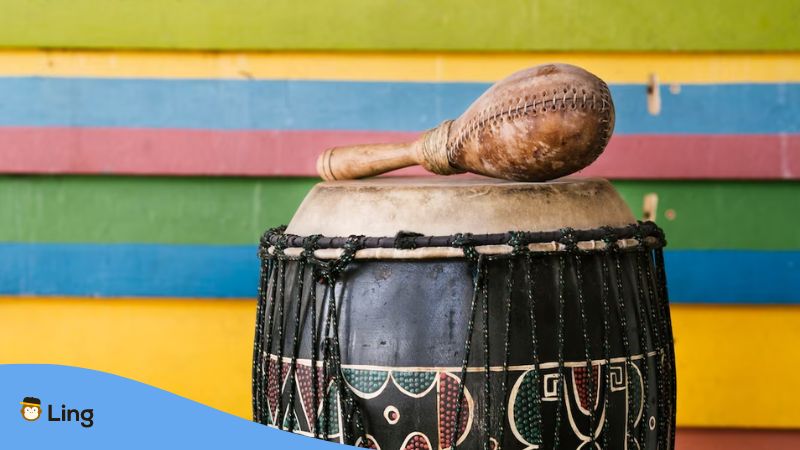Picture yourself strolling through the vibrant streets of Bangkok, the gentle hum of a melody catching your ear. That’s the mesmerizing charm of Thai traditional music!
In this all-in-one guide, we’ll explore the enchanting vocabulary and diverse styles that make Thai music a genuinely unforgettable experience.
Hold onto your hats, guys, because we’re about to embark on a melodious journey through the Land of Smiles!
Origins And Evolution Of Thai Traditional Music
Thai traditional music has been shaped by various cultural influences throughout history.
As we explore the origins and evolution of Thai classical music, we’ll see how these distinct forms emerged and how the impact of Western classical music has left its mark on Thai music.
Thai classical music, or “ดนตรีไทย” (dontrii thai), was historically influenced by the music of neighboring countries like Cambodia, Laos, and Myanmar.
In addition to these regional influences, Thai music has also been shaped by its own diverse cultural heritage.
The ancient kingdoms of Sukhothai, Ayutthaya, and Lanna each developed their own musical styles, eventually merging to create the foundation of traditional Thai music.
Over time, the music continued to evolve, incorporating elements of religious ceremonies, courtly events, and traditional theater.
Thai Traditional Music’s Unique Scales And Rhythms
So, what sets Thai traditional music apart from other musical genres? The unique scales and rhythms used in Thai music are key factors.
Thai classical music is based on a pentatonic scale system, while the rhythmic structures and patterns are intricate and varied.
A common scale in Thai classical music is the “กังวาน” (kangwan) scale, which consists of five notes.
The rhythmic structures in Thai music are often built on a “ชั้น” (chan) system, with each chan representing a different layer of rhythm.
For example, the “ชั้นเนื้อ” (chan nuea) is the main melody, while the “ชั้นล้อม” (chan laawm) provides rhythmic support.
These unique scales and rhythms contribute to the distinct and captivating sound of Thai traditional music.
As Thai music continues to evolve, it remains deeply connected to its rich cultural roots, ensuring that its enchanting melodies will endure for generations to come.

Key Instruments And Terminology
Thai traditional music features a range of fascinating instruments, each with unique characteristics and terminology.
Let’s explore the Thai various instruments that define traditional music.
- Stringed Instruments: Includes the “พิณ” (phin), a lute-like instrument, and the “กระหาย” (krahay), a bowed instrument.
- Wind Instruments: Includes the “ปี่” (pii), a double-reed oboe, and the “ขลุ่ย” (khlui), a bamboo flute.
- Percussion Instruments: Includes the “กลอง” (klong), a drum, and the “ตะโพน” (taphon), a barrel-shaped drum.
- Idiophones: Includes the “ระนาด” (ranat), a xylophone-like instrument, and the “ขิง” (khing), a pair of small cymbals.
Traditional Thai Music Regional Styles
Thai music showcases a rich diversity of regional styles, each with its unique vocabulary and captivating sounds.
Here, we’ll discuss the musical traditions of different regions in Thailand, exploring their distinctive features and terminology.
Central Plains
The Central Plains region of Thailand has played a significant role in shaping Thai popular music.
One popular vocal style in the Central Plains region is “ลำ” (lam), known for its fast-paced, rhythmic delivery.
The songs often tell stories, with singers engaging in witty repartee and wordplay.
Instruments commonly used in Central Plains music include the “ซอ” (saw), a fiddle-like instrument, and the “กษัตริย์” (khrueang sai), an ensemble of stringed and percussion instruments.
These instruments work together to create the lively, infectious sound that defines Central Plains’ music.
Northeast (Isan)
The Northeast region of Thailand, also known as Isan, is famous for its vibrant folk music scene.
“โมเล้ง” (molam) is an Isan dominant folk music featuring a combination of singing, storytelling, and instrumental accompaniment.
Singers in molam performances often engage in playful banter, with lyrics focusing on everyday life, love, and social issues.
Instruments in Isan music include the “กีต้า” (khaen), a mouth organ made of bamboo pipes, and the “พิณปากคูล” (phin pak khuul), a plucked lute.
These instruments provide the distinctive sounds and textures that make Isan music so engaging and memorable.
North (Lanna)
The Northern region of Thailand, known as Lanna, boasts a rich musical heritage that includes traditional dance music and classical Thai music.
Lanna’s music is characterized by its intricate melodies, complex rhythms, and diverse range of instruments.
Lanna’s traditional dance music, called “ฟ้อน” (fon), is characterized by its lively, upbeat tempo and use of instruments.
This includes the “ระนาดเอก” (ranat aek), a wooden xylophone, and the “กระงี่” (krang), a pair of small cymbals.
Classical Thai music from the Lanna region, known as “ดนตรีล้านนา” (dontri lanna), often features the “สะล้อ” (salaw), a plucked zither.
South (Pak Tai)
The Southern region of Thailand, known as Pak Tai, is home to unique traditional music styles that are distinct from those of other areas.
Music from this region reflects the influences of various cultures, including Malay and Indonesian elements.
“มโนราห์” (manora) is a popular dance and music genre in the South, featuring a combination of singing, dancing, and instrumental accompaniment.
Manora performances often include elaborate costumes, graceful movements, and engaging narratives that draw from Thai folklore and regional history.
Instruments commonly used in Pak Tai music include the “กลองยาว” (klong yao), a long drum, and the “ชิงชิ่ง” (ching ching), a pair of small, hand-held cymbals.

Vocal Styles In Thai Traditional Music
Thailand’s traditional music showcases an array of vocal styles, each with its unique characteristics and terminology.
Let’s examine the intricacies of various vocal styles defining Thai traditional music.
Phet
Phet, or “เพชร,” is a high-pitched, ornamental singing style used in Thai classical music.
It features complex melodic ornamentations and requires a high level of vocal control and skill.
Rabam
Rabam, or “รำวง,” is a melodic, narrative singing style dominating Thai popular music.
Typically accompanied by dance, it is used in various forms of Thai music and emphasizes storytelling.
Lam
Lam, or “ลำ,” is a vocal style from the northeastern region of Thailand, also known as Isan.
Lam is characterized by its fast-paced, rhythmic delivery and often features playful, witty lyrics.
Thai Traditional Music Ensembles
Thai traditional music is often performed by ensembles, each with its unique blend of instruments, arrangements, and styles.
Let me introduce you to some of the most well-known Thai traditional music ensembles and their defining features.
Piphat Ensemble
The “ปี่พาทย์” (piphat) ensemble is a classical Thai ensemble that predominantly features wind and percussion instruments.
Key instruments in a piphat ensemble include the pii, klong, and ranat.
This ensemble is commonly used for formal occasions like religious ceremonies or court performances.
Khrueang Sai Ensemble
The “ครื่องสาย” (khrueang sai) ensemble is another classical Thai ensemble that focuses on stringed and percussion instruments.
The ensemble often includes the saw, khrueang sai, and ranat, creating a melodic and harmonic blend of sounds.
Khrueang sai ensembles typically perform at traditional Thai events and celebrations.
Thai Jazz Band
Believe it or not, jazz was also developed to dominate Thai popular music and has also found its way into the traditional music of Thailand.
The first Thai jazz band, known as “วงแจ๊สไทย” (wong jaes thai), emerged in the early 20th century and incorporated elements of both traditional Thai music and Western jazz.
These bands typically feature a combination of Western instruments like saxophones and trumpets alongside traditional Thai instruments such as the ranat and khaen.

Thai Traditional Dance, Theater, And Popular Music Genres
Thai traditional music is not just limited to instrumental and vocal performances – it is also an integral part of traditional dance, theater, and popular music genres.
Let’s explore more of these art forms.
Khon And Lakhon
“โขน” (khon) and “ละคร” (lakhon) are two types of traditional Thai dance dramas that incorporate music, singing, and intricate choreography.
Khon is characterized by its elaborate costumes and masks, while lakhon often features more naturalistic movements and themes.
Both are usually accompanied by piphat ensembles and use storytelling to convey mythological or historical tales.
Likay
“ลิเก” (likay) is a type of Thai folk music and theatrical performance that blends music, dance, and comedy.
The Likay ensemble often includes stringed and percussion instruments, and the performances usually incorporate a combination of scripted and improvised elements.
Likay is popular in rural areas of Thailand and is often performed at local fairs and festivals.
Thai Popular Music
Finally, we come to Thai popular music – a diverse genre that has evolved over the past century to incorporate elements of rock music, jazz, and other Western styles like Thai country music.
In recent decades, famous Thai rock bands such as Carabao and Slot Machine have gained international recognition and retained traditional musical forms.
Jazz is also popular in Thailand, with bands like The Jazz Traffic Big Band and The Bangkok Connection blending traditional Thai music with jazz.
Useful Traditional Thai Music Vocabulary
So, you’re curious about traditional Thai music and want to learn some helpful vocabulary?
Here are some common Thai words and phrases about music that will give you a better understanding of the enchanting melodies and rhythms that define this unique musical style.
There you have it – 15 handy Thai words and phrases to help you better understand and appreciate traditional Thai music.
With this new vocabulary, you’re well on your way to deepening your connection to this mesmerizing musical culture.
Learn Thai Traditional Music With Ling!
As you can see, Thai traditional music is a rich and captivating art form with a deep history and diverse regional styles.
By exploring the vocabulary and styles that define Thai music, you can deepen your appreciation for this enchanting genre and gain insight into the cultural heritage of Thailand.
So why not take the next step and dive deeper into Thai music and culture?
With the Ling app, you can learn Thai and 60+ other languages through interactive lessons and fun activities.
In just 15 minutes a day, you can become proficient in a new language, including Thai and its music-related vocabulary.
Download the Ling app from App Store and Google Play now!





































































